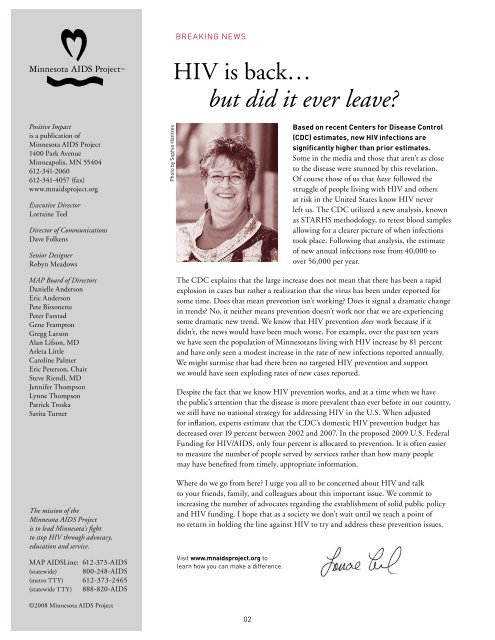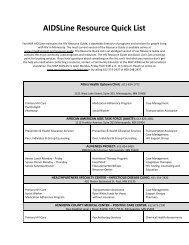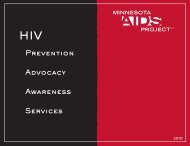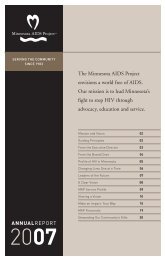BREAKING NEWSHIV is back…but did it ever leave?Positive Impactis a publication of<strong>Minnesota</strong> <strong>AIDS</strong> <strong>Project</strong>1400 Park AvenueMinneapolis, MN 55404612-341-2060612-341-4057 (fax)www.mnaidsproject.orgExecutive DirectorLorraine TeelDirector of CommunicationsDave FolkensSenior DesignerRobyn MeadowsPhoto by Sophia HantzesBased on recent Centers for Disease Control(CDC) estimates, new HIV infections aresignificantly higher than prior estimates.Some in the media and those that aren’t as closeto the disease were stunned by this revelation.Of course those of us that have followed thestruggle of people living with HIV and othersat risk in the United States know HIV neverleft us. The CDC utilized a new analysis, knownas STARHS methodology, to retest blood samplesallowing for a clearer picture of when infectionstook place. Following that analysis, the estimateof new annual infections rose from 40,000 toover 56,000 per year.MAP Board of DirectorsDanielle AndersonEric AndersonPete BissonettePeter FarstadGene FramptonGregg LarsonAlan Lifson, MDArleta LittleCaroline PalmerEric Peterson, ChairSteve Riendl, MDJennifer ThompsonLynne ThompsonPatrick TroskaSarita TurnerThe mission of the<strong>Minnesota</strong> <strong>AIDS</strong> <strong>Project</strong>is to lead <strong>Minnesota</strong>’s fightto stop HIV through advocacy,education and service.MAP <strong>AIDS</strong>Line: 612-373-<strong>AIDS</strong>(statewide) 800-248-<strong>AIDS</strong>(metro TTY) 612-373-2465(statewide TTY) 888-820-<strong>AIDS</strong>The CDC explains that the large increase does not mean that there has been a rapidexplosion in cases but rather a realization that the virus has been under reported forsome time. Does that mean prevention isn’t working? Does it signal a dramatic changein trends? No, it neither means prevention doesn’t work nor that we are experiencingsome dramatic new trend. We know that HIV prevention does work because if itdidn’t, the news would have been much worse. For example, over the past ten yearswe have seen the population of <strong>Minnesota</strong>ns living with HIV increase by 81 percentand have only seen a modest increase in the rate of new infections reported annually.We might surmise that had there been no targeted HIV prevention and supportwe would have seen exploding rates of new cases reported.Despite the fact that we know HIV prevention works, and at a time when we havethe public’s attention that the disease is more prevalent than ever before in our country,we still have no national strategy for addressing HIV in the U.S. When adjustedfor inflation, experts estimate that the CDC’s domestic HIV prevention budget hasdecreased over 19 percent between 2002 and 2007. In the proposed 2009 U.S. FederalFunding for HIV/<strong>AIDS</strong>, only four percent is allocated to prevention. It is often easierto measure the number of people served by services rather than how many peoplemay have benefited from timely, appropriate information.Where do we go from here? I urge you all to be concerned about HIV and talkto your friends, family, and colleagues about this important issue. We commit toincreasing the number of advocates regarding the establishment of solid public policyand HIV funding. I hope that as a society we don’t wait until we reach a point ofno return in holding the line against HIV to try and address these prevention issues.Visit www.mnaidsproject.org tolearn how you can make a difference.©2008 <strong>Minnesota</strong> <strong>AIDS</strong> <strong>Project</strong>02
P O S I T I V E I M P A C T • F A L L 2 0 0 8TIBET continued from coverThe skills and knowledge theygained at MAP, they said, werethe basis of the presentations theygave, though they were carefulto tailor their message as much aspossible to Dharamsala’s culture,conducting informal interviewsbeforehand to gauge reactionsto different topics.Both said the experience leftthem eager to continue educatingpeople about HIV, whether in themountains of India or in the streetsof Minneapolis.“I walked away very awe-inspired,”Jamie said. “I was introduced as an<strong>AIDS</strong> activist. It was the first timeever that I’ve been introduced asthat. I never thought of it that way.I’m just trying to help people.”“You can affect the world bytelling one person at a time.”Hallie said she now has moreconfidence to speak out onissues like HIV.“I’ve had a long, hard strugglewith the ability to use my voicefor change,” she said. “It is reallyempowering to come back feelingI can make a difference.”Educating people about HIVdoesn’t require a trip around theworld, she and Jamie emphasized.“You can affect the world by tellingone person at a time,” Jamie said.“And we have to be involved inour communities and supportorganizations here.”To learn more about opportunitiesto educate people aboutHIV contact Michael Lee,MAP volunteer coordinator, atvolunteer@mnaidsproject.orgor 612-373-9160.all over the MAPAt MAPMAP <strong>AIDS</strong>Line NowFeatures Online ChatThe <strong>Minnesota</strong> <strong>AIDS</strong> <strong>Project</strong> <strong>AIDS</strong>LineOnline is designed to provide oneon-oneassistance via the Internet.The new <strong>AIDS</strong>Line Online can:• Answer basic questions regardingHIV, including transmission concerns,current statistics and basic resources.• Provide accurate and non-judgmentalrisk assessments to help determineif users are at risk of HIV infection ortransmission, locate an HIV testing siteif needed, and offer realistic suggestionsto reduce risk.• Complete personalized assessmentsfor people living with HIV to help locateresources and information.• Help navigate the <strong>Minnesota</strong> <strong>AIDS</strong><strong>Project</strong> Web site, including the HIVResource Guide, to find specificpersonalized resource information.Users simply click the button on thehomepage at www.mnaidsproject.orgto have a confidentialchat with an <strong>AIDS</strong>Linecommunity educator.<strong>AIDS</strong>Line Online isavailable Monday–Friday, 9:00 a.m.–5:30 p.m. Central TimeEric Peterson AssumesRole as MAP Board ChairIn April 2008, Eric Peterson becamechairperson of the <strong>Minnesota</strong> <strong>AIDS</strong><strong>Project</strong>’s board of directors. As an attorneyat Dorsey & Whitney, L.L.P., he counselspublic and private clients in the healthcare field. Eric earned graduate degreesin public health and social work beforeattending law school. He previously heldpositions as a health policy analyst atthe Centers for Disease Control and asa clinical social worker at a pediatrichospital. Eric is also on the CourageCenter board and was elected to theMAP board in February 2005.Sarita Turner Joins the MAP BoardSarita Turner is a seasoned nonprofitexecutive, who recently joined the WestBroadway Business and Area Coalitionas executive director. Previously, she heldthe same position at the Cecil NewmanResource Center. She has worked forthe state, as planning director for theGeneral Crime Victims Program and asa coordinator responsible for Communitiesof Color Outreach/Legislative Support forthe <strong>Minnesota</strong> Coalition Against SexualAssault. She has wide-ranging volunteerand board experience and serves as atrustee for Fellowship Missionary BaptistChurch. Sarita was elected to the MAPboard in August 2008.NationalSafer Sex and HIV Awarenessat the National ConventionsTo spread the message about the needfor broad-based HIV education anda unified national strategy to stop HIV,the <strong>Minnesota</strong> <strong>AIDS</strong> <strong>Project</strong> distributedsafer sex kits with important informationabout HIV at local bars during the recentRepublican National Convention. Inaddition, MAP partnered with the Colorado<strong>AIDS</strong> <strong>Project</strong> who distributed the kits atthe Democratic National Convention.“HIV should be a non-partisan issue.Prevention information is essential foreveryone and, for those that are politicallyengaged, they should also be aware ofthe public health threat that HIV presents,”said Lorraine Teel, executive directorof the <strong>Minnesota</strong> <strong>AIDS</strong> <strong>Project</strong>.03









